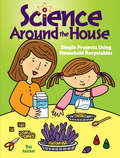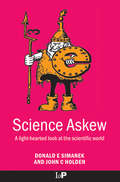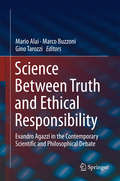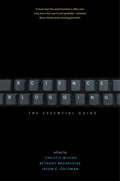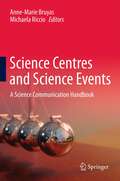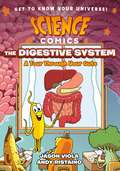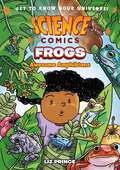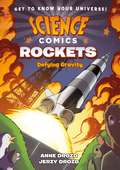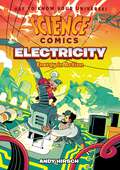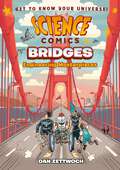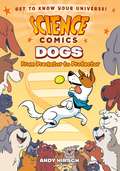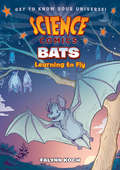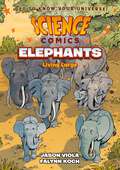- Table View
- List View
Science Around the House: Simple Projects Using Household Recyclables (Dover Children's Science Bks.)
by Roz FulcherWith this charmingly illustrated book--and a little help from a parent or other grownup--kids can conduct fun-filled science experiments using recycled household items. They'll learn about sound waves by transforming ordinary cardboard tubing into music-making didgeridoos and kazoos. Other eye-opening activities involve building a battery with pennies and tinfoil, playing a fishing game that illustrates the principles of magnetic force, and using food coloring and fizzy antacid tablets to make a lava lamp. Additional projects include discovering the differences between crickets and grasshoppers, mixing up a batch of invisible ink, and learning how to clone plants. Easy-to-follow instructions explain how to make a butterfly feeder, a birdbath, eggshell planters, a windsock, a string telephone, and other items. Each activity features a simple explanation of its underlying scientific principles.
Science Arts: Discovering Science Through Art Experiences
by Maryann F. Kohl Jean PotterChildren explore the world of science through art with these open-ended experiments categorized by scientific topic. Hundreds of art activities amaze and delight children as they discover the magic of crystals, light, constellations, plants, and more. A unique approach to learning basic science concepts.
Science Arts: Exploring Science Through Hands-On Art Projects (Bright Ideas for Learning #4)
by Jean Potter MaryAnn F Kohl K. Whelan DeryGet ready to explore the world of science through art with these open-ended experiments! Science Arts introduces the scientific magic of crystals, light, constellations, plants, and more through creative art projects. Each of the more than 100 hands-on projects is designed to help children discover essential science topics through a creative process unique to each individual. Concepts include light and sight, motion and energy, and nature and ecology. Science Arts provides both teachers and parents with a diverse range of activities for making science creative, fun and fascinating. The possibilities are wide open and endless!
Science As Social Knowledge: Values And Objectivity In Scientific Inquiry
by Helen E. Longino<P> Conventional wisdom has it that the sciences, properly pursued, constitute a pure, value-free method of obtaining knowledge about the natural world. <P>In light of the social and normative dimensions of many scientific debates, Helen Longino finds that general accounts of scientific methodology cannot support this common belief. Focusing on the notion of evidence, the author argues that a methodology powerful enough to account for theories of any scope and depth is incapable of ruling out the influence of social and cultural values in the very structuring of knowledge. <P>The objectivity of scientific inquiry can nevertheless be maintained, she proposes, by understanding scientific inquiry as a social rather than an individual process. Seeking to open a dialogue between methodologists and social critics of the sciences, Longino develops this concept of "contextual empiricism" in an analysis of research programs that have drawn criticism from feminists. <P>Examining theories of human evolution and of prenatal hormonal determination of "gender-role" behavior, of sex differences in cognition, and of sexualorientation, the author shows how assumptions laden with social values affect the description, presentation, and interpretation of data. <P>In particular, Longino argues that research on the hormonal basis of "sex-differentiated behavior" involves assumptions not only about gender relations but also about human action and agency. She concludes with a discussion of the relation between science, values, and ideology, based on the work of Habermas, Foucault, Keller, and Haraway.
Science Askew: A Light-hearted Look at the Scientific World (Institute of Physics Conference Series)
by Donald E Simanek John. HoldenCopiously illustrated throughout with many fine drawings by John C. Holden, Science Askew: A Light-Hearted Look at the Scientific World is a refreshing antidote to the daily grind. From continental drip to the life of Konrad Finagle via the murky depths of Loch Ness, we are treated to an off-kilter trip through the scientific world. This pocket-siz
Science Between Truth and Ethical Responsibility
by Mario Alai Marco Buzzoni Gino TarozziThis book offers the most complete and up-to-date overview of the philosophical work of Evandro Agazzi, presently the most important Italian philosopher of science and one of the most influential in the world. Scholars from seven countries explore his contributions in areas ranging from philosophy of physics and general philosophy of science to bioethics, philosophy of mathematics and logic, epistemology of the social sciences and history of science, philosophy of language and artificial intelligence, education and anthropology, metaphysics and philosophy of religion. Agazzi developed a complete and coherent philosophical system, anticipating some of the turns in the philosophy of science after the crisis of logical empiricism and exerting an equal influence on continental hermeneutic philosophy. His work is characterized by an original synthesis of contemporary analytic philosophy, phenomenology and classical philosophy, including the scholastic tradition and these threads are reflected in the different backgrounds of the contributors to this book. While upholding the epistemological value of science against scepticism and relativism, Agazzi eschews scientism by stressing the equal importance of non-scientific forms of thought, such as metaphysics and religion. While defending the freedom of research as a cognitive enterprise, he argues that as a human and social practice it must nonetheless respect ethical constraints.
Science Blogging
by Bethany Brookshire Christie Wilcox Jason G. GoldmanHere is the essential how-to guide for communicating scientific research and discoveries online, ideal for journalists, researchers, and public information officers looking to reach a wide lay audience. Drawing on the cumulative experience of twenty-seven of the greatest minds in scientific communication, this invaluable handbook targets the specific questions and concerns of the scientific community, offering help in a wide range of digital areas, including blogging, creating podcasts, tweeting, and more. With step-by-step guidance and one-stop expertise, this is the book every scientist, science writer, and practitioner needs to approach the Wild West of the Web with knowledge and confidence.
Science Can Be Fun
by Munro LeafLearn why we have night and day, why birds can fly but we fall back to the ground, and why sometimes water is a liquid and sometimes is a solid.
Science Centres and Science Events
by Anne-Marie Bruyas Michaela RiccioThe idea for this text stemmed from the fruitful experience gathered during the training course of 9 Nigerian university students organized in Naples from 3 to 18 September 2008 by the team of Fondazione IDIS-Città della Scienza under the project Science Centre Owerri. The training course turned out to be not only an educational opportunity to acquire knowledge and skills for these students, but also a real and practical tool that later led to the realization of the first Science Festival of Owerri in Nigeria in May 2009. This in turn sparked the idea of creating a highly practical handbook for those who want to face the challenge of developing new projects for the dissemination and socialization of science in developing countries. In these countries, the role of scientific education and training in schools is not sufficient to arouse scientific curiosity among young people and make the population aware of the importance of scientific knowledge in everyday life. Moreover science and technology are indispensable tools for people's empowerment and should be supported with actions that encourage curiosity about science and the intelligent use of technology to bridge the divide with developed countries. It is therefore necessary to set up activities that are carefully targeted to promote and communicate science. The text has been designed as a practical guide to be used in a variety of contexts: scientific events or more structured science festivals, training, the creation of scientific cultural associations, and the development of new science centres. Besides being an excellent tool for training and supporting the design and planning phases, the manual can also be used as a reference work for institutions and local cultural services which have to select projects of this type.
Science Chapter Booklet: Chapter 06, Water Cycle and Weather (Grade #4)
by Scott ForesmanThis is a chapter booklet on water cycle and weather.
Science Chapter Booklet: Chapter 07, Rocks and Soil (Grade #3)
by Scott ForesmanThis is a Chapter Booklet on rocks and soil.
Science Chapter Booklet: Chapter 08, Minerals and Rocks (Grade #4)
by Scott ForesmanThis is a chapter booklet on minerals and rocks.
Science Chapter Booklet: Chapter 09, Changes to Earth's Surface (Grade #4)
by Scott ForesmanThis is a chapter booklet on changes to earth's surface.
Science Chapter Booklet: Chapter 09, Natural Resources (Grade #3)
by Scott ForesmanThis is a Chapter Booklet on natural resources.
Science Chapter Booklet: Chapter 13, Electricity and Magnetism (Grade #4)
by Scott ForesmanThis is a Chapter Booklet on electricity and magnetism.
Science Chapter Booklet: Chapter 14, Sound (Grade #3)
by Scott ForesmanThis is a chapter booklet on sound.
Science Comics: A Tour Through Your Guts (Science Comics)
by Jason ViolaIn Science Comics: The Digestive System, visit the inside of your mouth, stomach, liver, intestines, and other organs that make up the gastrointestinal tract! Your guide to the gut is a friendly bacterium who will take you on a journey beyond imagination. Uncover how food is transformed into nutrients! Explore strange and dangerous glands! Behold the wonders of saliva, mucus, and vomit! Writer Jason Viola and illustrator Andy Ristaino provide a trip to the toilet you will never forget!Every volume of Science Comics offers a complete introduction to a particular topic—dinosaurs, the solar system, volcanoes, bats, robots, and more! Whether you're a fourth grader doing a natural science unit at school or a thirty-year-old with a secret passion for airplanes, these graphic novels are for you!
Science Comics: Awesome Amphibians (Science Comics)
by Liz PrinceHop to it with Science Comics: Frogs, a new volume of First Second's fan-favorite nonfiction graphic novel series! With their signature sounds, athletic tongues, and bulging eyes, there’s a lot to love about frogs! But did you know that they soak up air and even liquid through their skin? Or that they use their eyes to swallow food? From tiny tadpoles in water to boisterous bullfrogs on land, the life cycle of these amphibious acrobats is one of the coolest examples of metamorphosis around. So pull up a lily pad and dive in, because the frog facts in this book will truly give you something to croak about!
Science Comics: Defying Gravity (Science Comics)
by Anne Drozd Jerzy DrozdBlast off! Discover the history of rockets and their impact on the future with Anne and Jerzy Drozd in this volume of Science Comics, the action-packed nonfiction graphic novel series for middle-grade readers! Every volume of Science Comics offers a complete introduction to a particular topic—dinosaurs, coral reefs, the solar system, volcanoes, bats, flying machines, and many more. These gorgeously illustrated graphic novels offer wildly entertaining views of their subjects. Whether you're a fourth grader doing a natural science unit at school or a thirty-year-old with a secret passion for airplanes, these books are for you!This volume: In Rockets we explore the 2,000 years that rockets have been in existence. We dive into Newton's Laws of Motion—learning all about gravity, force, acceleration, and the history of rockets made in the past and rockets to be made in the future!
Science Comics: Energy in Action (Science Comics)
by Andy HirschGet a charge out of Electricity, a new edition to the Science Comics series!Giant monsters are on the warpath, and it’s Menlo the mech’s job to protect the city! But when this metal marvel is shut down by an unlucky lightning strike, a resourceful engineer and his high-energy niece will have to find a way to plug in and power up to save everyone from certain doom!From simple circuits to giant grids, fossil fuel power plants to wind farms, electricity keeps the world running. In Science Comics: Electricity, you’ll discover where electricity comes from, why lightning suddenly strikes, and how we’ve harnessed it all to turn the lights on in your room. Ready for action? Get energized with electricity!
Science Comics: Engineering Masterpieces (Science Comics)
by Dan ZettwochSuspend your disbelief with Science Comics: Bridges, a new volume of First Second's STEM graphic novel series!Follow Bea, Archie, Trudy, and Spencer (otherwise known as the BATS!) as they crisscross the globe using every type of bridge: beam, arch, truss, and suspension. From ancient low-slung rope bridges to modern hi-tech towers of steel, they’ll traverse ‘em all. Their journey will take them through history and connect them with new ideas and different cultures. Along the way they'll identify the dangerous forces trying to bring bridges crashing down, and how to defeat them…through engineering!
Science Comics: From Predator to Protector (Science Comics)
by Andy HirschHow well do you know our favorite furry companion? Did they really descend from wolves? What's the difference between a Chihuahua and a Saint Bernard? And just how smart are they? Join one friendly mutt on a journey to discover the secret origin of dogs, how genetics and evolution shape species, and where in the world his favorite ball bounced off to.Every volume of Science Comics offers a complete introduction to a particular topic—dinosaurs, coral reefs, the solar system, volcanoes, bats, flying machines, and more. These gorgeously illustrated graphic novels offer wildly entertaining views of their subjects. Whether you're a fourth grader doing a natural science unit at school or a thirty year old with a secret passion for airplanes, these books are for you!
Science Comics: Learning to Fly (Science Comics)
by Falynn KochEvery volume of Science Comics offers a complete introduction to a particular topic—dinosaurs, coral reefs, the solar system, volcanoes, bats, flying machines, and more. These gorgeously illustrated graphic novels offer wildly entertaining views of their subjects. Whether you're a fourth grader doing a natural science unit at school or a thirty year old with a secret passion for airplanes, these books are for you!This volume: In Bats, we follow a little brown bat whose wing is injured by humans on a nature hike. He is taken to a bat rehabilitation center where he meets many different species of bats. They teach him how they fly, what they eat, and where they like to live.
Science Comics: Living Large (Science Comics)
by Jason ViolaHave you herd? There's a new volume in First Second's STEM graphic novel series: Science Comics: Elephants!Did you know elephants are the world's largest land animals? Male African elephants can reach ten feet tall and weigh up to 16,500 pounds! These endangered animals are beloved for their massive ears, thick skin, and flexible trunks, as well as their remarkable intelligence and empathy. And despite their size, the more you get to know them, the more you'll realize humans and elephants have a lot in common!

